JEEP COMPASS 2019 Owner handbook (in English)
Manufacturer: JEEP, Model Year: 2019, Model line: COMPASS, Model: JEEP COMPASS 2019Pages: 362, PDF Size: 6.23 MB
Page 171 of 362
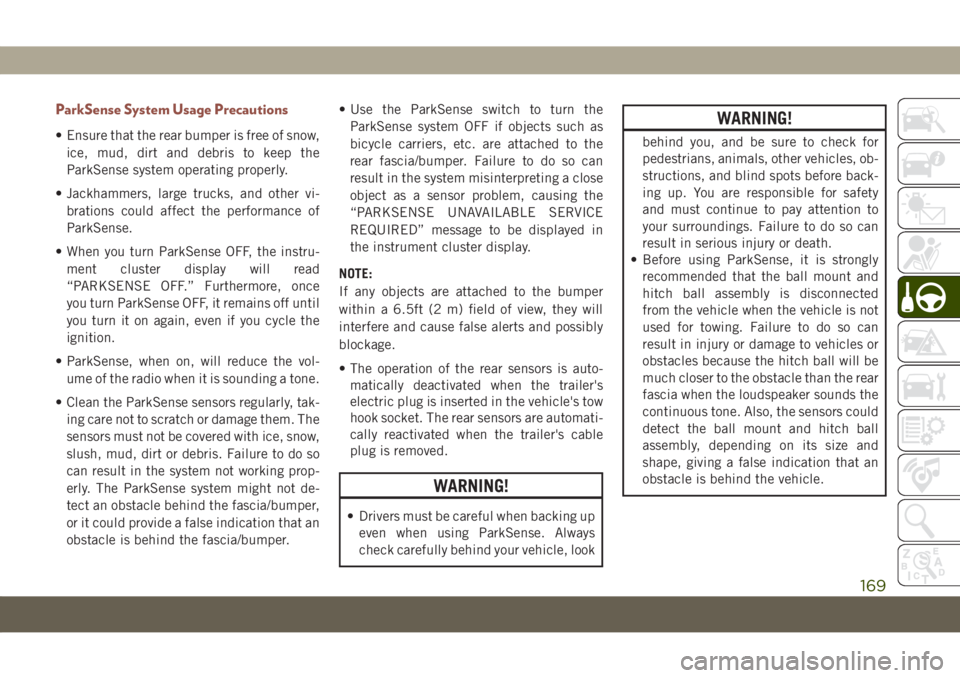
ParkSense System Usage Precautions
ŌĆó Ensure that the rear bumper is free of snow,
ice, mud, dirt and debris to keep the
ParkSense system operating properly.
ŌĆó Jackhammers, large trucks, and other vi-
brations could affect the performance of
ParkSense.
ŌĆó When you turn ParkSense OFF, the instru-
ment cluster display will read
ŌĆ£PARKSENSE OFF.ŌĆØ Furthermore, once
you turn ParkSense OFF, it remains off until
you turn it on again, even if you cycle the
ignition.
ŌĆó ParkSense, when on, will reduce the vol-
ume of the radio when it is sounding a tone.
ŌĆó Clean the ParkSense sensors regularly, tak-
ing care not to scratch or damage them. The
sensors must not be covered with ice, snow,
slush, mud, dirt or debris. Failure to do so
can result in the system not working prop-
erly. The ParkSense system might not de-
tect an obstacle behind the fascia/bumper,
or it could provide a false indication that an
obstacle is behind the fascia/bumper.ŌĆó Use the ParkSense switch to turn the
ParkSense system OFF if objects such as
bicycle carriers, etc. are attached to the
rear fascia/bumper. Failure to do so can
result in the system misinterpreting a close
object as a sensor problem, causing the
ŌĆ£PARKSENSE UNAVAILABLE SERVICE
REQUIREDŌĆØ message to be displayed in
the instrument cluster display.
NOTE:
If any objects are attached to the bumper
within a 6.5ft (2 m) field of view, they will
interfere and cause false alerts and possibly
blockage.
ŌĆó The operation of the rear sensors is auto-
matically deactivated when the trailer's
electric plug is inserted in the vehicle's tow
hook socket. The rear sensors are automati-
cally reactivated when the trailer's cable
plug is removed.
WARNING!
ŌĆó Drivers must be careful when backing up
even when using ParkSense. Always
check carefully behind your vehicle, look
WARNING!
behind you, and be sure to check for
pedestrians, animals, other vehicles, ob-
structions, and blind spots before back-
ing up. You are responsible for safety
and must continue to pay attention to
your surroundings. Failure to do so can
result in serious injury or death.
ŌĆó Before using ParkSense, it is strongly
recommended that the ball mount and
hitch ball assembly is disconnected
from the vehicle when the vehicle is not
used for towing. Failure to do so can
result in injury or damage to vehicles or
obstacles because the hitch ball will be
much closer to the obstacle than the rear
fascia when the loudspeaker sounds the
continuous tone. Also, the sensors could
detect the ball mount and hitch ball
assembly, depending on its size and
shape, giving a false indication that an
obstacle is behind the vehicle.
169
Page 172 of 362
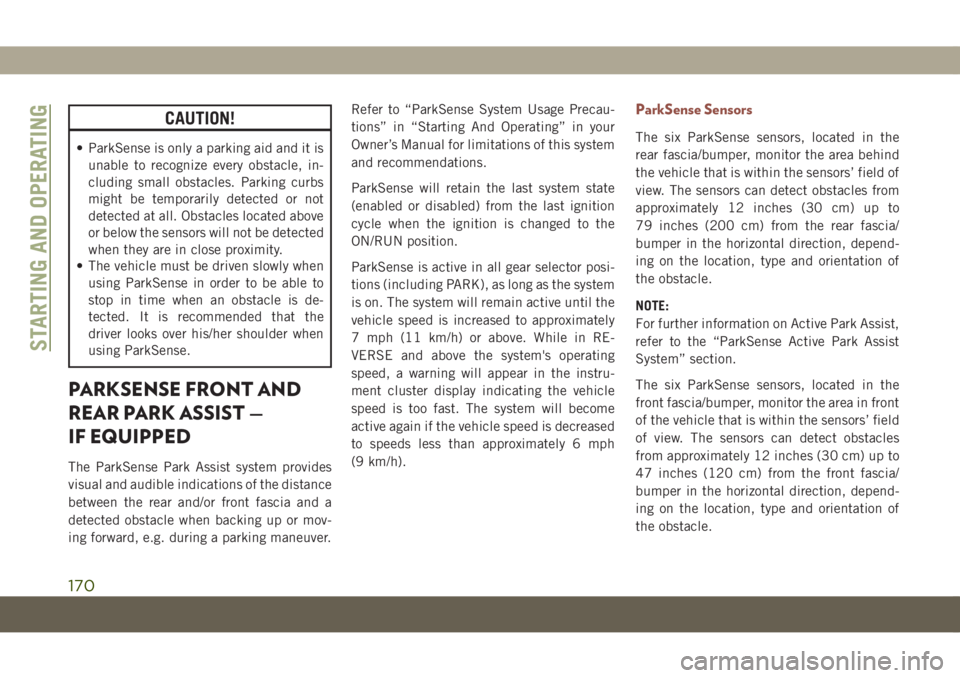
CAUTION!
ŌĆó ParkSense is only a parking aid and it is
unable to recognize every obstacle, in-
cluding small obstacles. Parking curbs
might be temporarily detected or not
detected at all. Obstacles located above
or below the sensors will not be detected
when they are in close proximity.
ŌĆó The vehicle must be driven slowly when
using ParkSense in order to be able to
stop in time when an obstacle is de-
tected. It is recommended that the
driver looks over his/her shoulder when
using ParkSense.
PARKSENSE FRONT AND
REAR PARK ASSIST ŌĆö
IF EQUIPPED
The ParkSense Park Assist system provides
visual and audible indications of the distance
between the rear and/or front fascia and a
detected obstacle when backing up or mov-
ing forward, e.g. during a parking maneuver.Refer to ŌĆ£ParkSense System Usage Precau-
tionsŌĆØ in ŌĆ£Starting And OperatingŌĆØ in your
OwnerŌĆÖs Manual for limitations of this system
and recommendations.
ParkSense will retain the last system state
(enabled or disabled) from the last ignition
cycle when the ignition is changed to the
ON/RUN position.
ParkSense is active in all gear selector posi-
tions (including PARK), as long as the system
is on. The system will remain active until the
vehicle speed is increased to approximately
7 mph (11 km/h) or above. While in RE-
VERSE and above the system's operating
speed, a warning will appear in the instru-
ment cluster display indicating the vehicle
speed is too fast. The system will become
active again if the vehicle speed is decreased
to speeds less than approximately 6 mph
(9 km/h).
ParkSense Sensors
The six ParkSense sensors, located in the
rear fascia/bumper, monitor the area behind
the vehicle that is within the sensorsŌĆÖ field of
view. The sensors can detect obstacles from
approximately 12 inches (30 cm) up to
79 inches (200 cm) from the rear fascia/
bumper in the horizontal direction, depend-
ing on the location, type and orientation of
the obstacle.
NOTE:
For further information on Active Park Assist,
refer to the ŌĆ£ParkSense Active Park Assist
SystemŌĆØ section.
The six ParkSense sensors, located in the
front fascia/bumper, monitor the area in front
of the vehicle that is within the sensorsŌĆÖ field
of view. The sensors can detect obstacles
from approximately 12 inches (30 cm) up to
47 inches (120 cm) from the front fascia/
bumper in the horizontal direction, depend-
ing on the location, type and orientation of
the obstacle.
STARTING AND OPERATING
170
Page 173 of 362
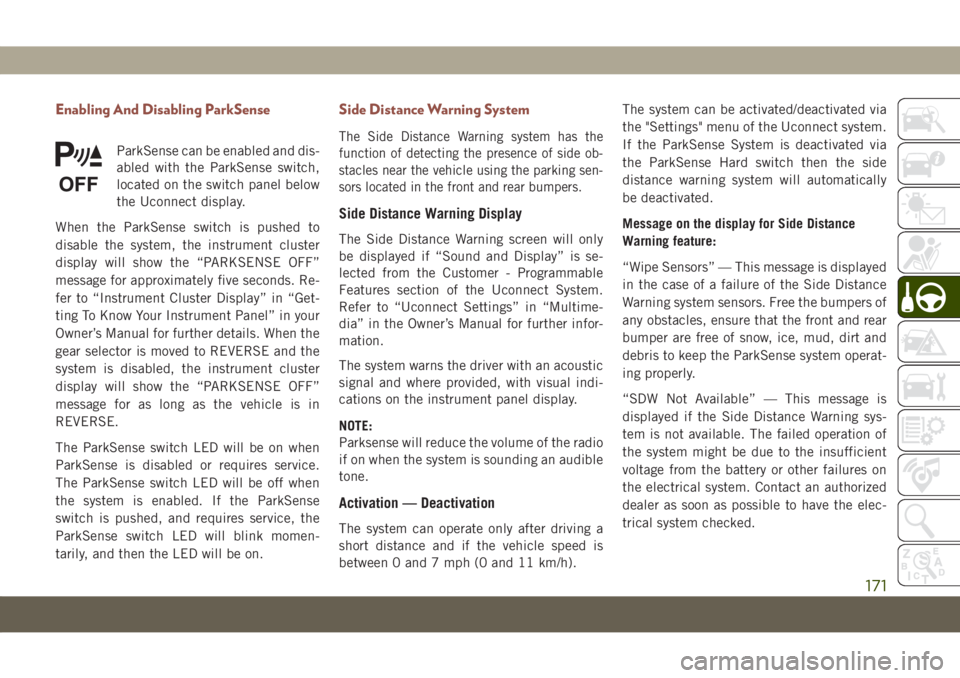
Enabling And Disabling ParkSense
ParkSense can be enabled and dis-
abled with the ParkSense switch,
located on the switch panel below
the Uconnect display.
When the ParkSense switch is pushed to
disable the system, the instrument cluster
display will show the ŌĆ£PARKSENSE OFFŌĆØ
message for approximately five seconds. Re-
fer to ŌĆ£Instrument Cluster DisplayŌĆØ in ŌĆ£Get-
ting To Know Your Instrument PanelŌĆØ in your
OwnerŌĆÖs Manual for further details. When the
gear selector is moved to REVERSE and the
system is disabled, the instrument cluster
display will show the ŌĆ£PARKSENSE OFFŌĆØ
message for as long as the vehicle is in
REVERSE.
The ParkSense switch LED will be on when
ParkSense is disabled or requires service.
The ParkSense switch LED will be off when
the system is enabled. If the ParkSense
switch is pushed, and requires service, the
ParkSense switch LED will blink momen-
tarily, and then the LED will be on.
Side Distance Warning System
The Side Distance Warning system has the
function of detecting the presence of side ob-
stacles near the vehicle using the parking sen-
sors located in the front and rear bumpers.
Side Distance Warning Display
The Side Distance Warning screen will only
be displayed if ŌĆ£Sound and DisplayŌĆØ is se-
lected from the Customer - Programmable
Features section of the Uconnect System.
Refer to ŌĆ£Uconnect SettingsŌĆØ in ŌĆ£Multime-
diaŌĆØ in the OwnerŌĆÖs Manual for further infor-
mation.
The system warns the driver with an acoustic
signal and where provided, with visual indi-
cations on the instrument panel display.
NOTE:
Parksense will reduce the volume of the radio
if on when the system is sounding an audible
tone.
Activation ŌĆö Deactivation
The system can operate only after driving a
short distance and if the vehicle speed is
between 0 and 7 mph (0 and 11 km/h).The system can be activated/deactivated via
the "Settings" menu of the Uconnect system.
If the ParkSense System is deactivated via
the ParkSense Hard switch then the side
distance warning system will automatically
be deactivated.
Message on the display for Side Distance
Warning feature:
ŌĆ£Wipe SensorsŌĆØ ŌĆö This message is displayed
in the case of a failure of the Side Distance
Warning system sensors. Free the bumpers of
any obstacles, ensure that the front and rear
bumper are free of snow, ice, mud, dirt and
debris to keep the ParkSense system operat-
ing properly.
ŌĆ£SDW Not AvailableŌĆØ ŌĆö This message is
displayed if the Side Distance Warning sys-
tem is not available. The failed operation of
the system might be due to the insufficient
voltage from the battery or other failures on
the electrical system. Contact an authorized
dealer as soon as possible to have the elec-
trical system checked.
171
Page 174 of 362

Operation With A Trailer
The system is automatically deactivated
when the trailer's electric plug is inserted in
the vehicle's tow hook socket. The rear sen-
sors are automatically reactivated when the
trailer's cable plug is removed.
ParkSense Usage Precautions
Some conditions may influence the perfor-
mance of the Side Distance Warning System:
NOTE:
ŌĆó Ensure that the front and rear bumper are
free of snow, ice, mud, dirt and debris to
keep the ParkSense system operating prop-
erly.
ŌĆó Construction equipment, large trucks, and
other vibrations could affect the perfor-
mance of ParkSense.
ŌĆó When you turn ParkSense off, the message
to appear in the instrument cluster display
will read ŌĆ£PARKSENSE OFF.ŌĆØ Furthermore,
once you turn ParkSense off, it remains off
until you turn it on again, even if you cycle
the ignition key.ŌĆó ParkSense, when on, will reduce the vol-
ume of the radio when it is sounding a tone.
ŌĆó Clean the ParkSense sensors regularly, tak-
ing care not to scratch or damage them.
The sensors must not be covered with ice,
snow, slush, mud, dirt or debris. Failure to
do so can result in the system not working
properly. The ParkSense system might not
detect an obstacle behind or in front of the
fascia/bumper, or it could provide a false
indication that an obstacle is behind or in
front of the fascia/bumper.
ŌĆó The presence of a tow hook without a trailer
may interfere with the correct operation of
the parking sensors. Before using the
ParkSense system, it is recommended to
remove the removable tow hook ball assem-
bly and any attachments from the vehicle
when it is not used for towing operations. If
you wish to leave the tow hook fitted with-
out towing a trailer, it is advisable to con-
tact your authorized dealer for the
ParkSense system update operations be-
cause the tow hook could be detected as an
obstacle by the central sensors.
WARNING!
ŌĆó Drivers must be careful when backing up
even when using ParkSense. Always
check carefully behind your vehicle,
look behind you, and be sure to check
for pedestrians, animals, other vehicles,
obstructions, and blind spots before
backing up. You are responsible for
safety and must continue to pay atten-
tion to your surroundings. Failure to do
so can result in serious injury or death.
ŌĆó Before using ParkSense, it is strongly
recommended that the ball mount and
hitch ball assembly is disconnected
from the vehicle when the vehicle is not
used for towing. Failure to do so can
result in injury or damage to vehicles or
obstacles because the hitch ball will be
much closer to the obstacle than the
rear fascia when the loudspeaker sounds
the continuous tone. Also, the sensors
could detect the ball mount and hitch
ball assembly, depending on its size and
shape, giving a false indication that an
obstacle is behind the vehicle.
STARTING AND OPERATING
172
Page 175 of 362
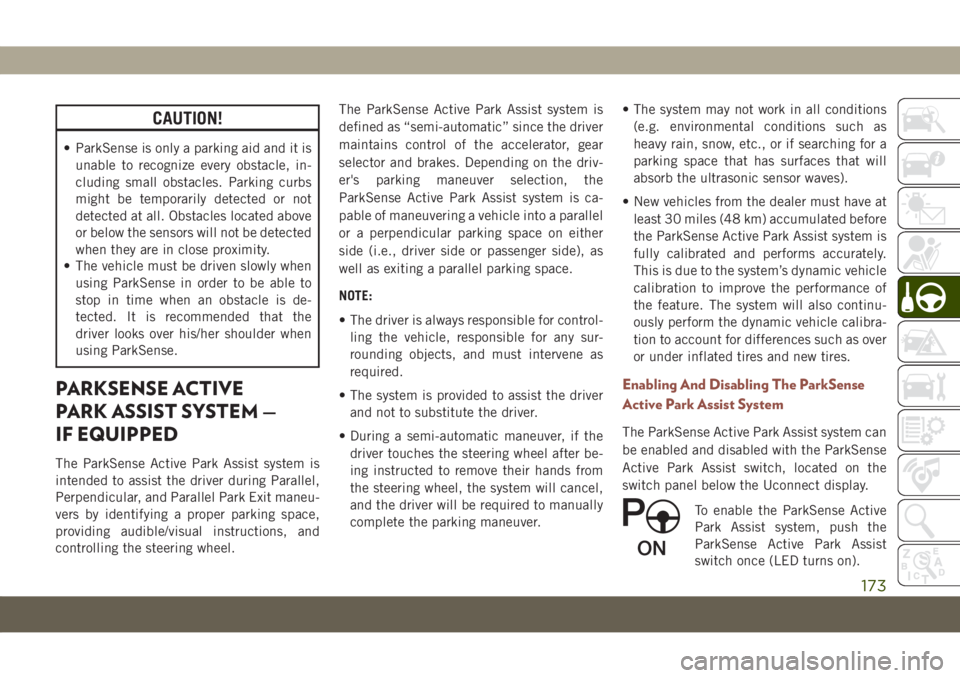
CAUTION!
ŌĆó ParkSense is only a parking aid and it is
unable to recognize every obstacle, in-
cluding small obstacles. Parking curbs
might be temporarily detected or not
detected at all. Obstacles located above
or below the sensors will not be detected
when they are in close proximity.
ŌĆó The vehicle must be driven slowly when
using ParkSense in order to be able to
stop in time when an obstacle is de-
tected. It is recommended that the
driver looks over his/her shoulder when
using ParkSense.
PARKSENSE ACTIVE
PARK ASSIST SYSTEM ŌĆö
IF EQUIPPED
The ParkSense Active Park Assist system is
intended to assist the driver during Parallel,
Perpendicular, and Parallel Park Exit maneu-
vers by identifying a proper parking space,
providing audible/visual instructions, and
controlling the steering wheel.The ParkSense Active Park Assist system is
defined as ŌĆ£semi-automaticŌĆØ since the driver
maintains control of the accelerator, gear
selector and brakes. Depending on the driv-
er's parking maneuver selection, the
ParkSense Active Park Assist system is ca-
pable of maneuvering a vehicle into a parallel
or a perpendicular parking space on either
side (i.e., driver side or passenger side), as
well as exiting a parallel parking space.
NOTE:
ŌĆó The driver is always responsible for control-
ling the vehicle, responsible for any sur-
rounding objects, and must intervene as
required.
ŌĆó The system is provided to assist the driver
and not to substitute the driver.
ŌĆó During a semi-automatic maneuver, if the
driver touches the steering wheel after be-
ing instructed to remove their hands from
the steering wheel, the system will cancel,
and the driver will be required to manually
complete the parking maneuver.ŌĆó The system may not work in all conditions
(e.g. environmental conditions such as
heavy rain, snow, etc., or if searching for a
parking space that has surfaces that will
absorb the ultrasonic sensor waves).
ŌĆó New vehicles from the dealer must have at
least 30 miles (48 km) accumulated before
the ParkSense Active Park Assist system is
fully calibrated and performs accurately.
This is due to the systemŌĆÖs dynamic vehicle
calibration to improve the performance of
the feature. The system will also continu-
ously perform the dynamic vehicle calibra-
tion to account for differences such as over
or under inflated tires and new tires.
Enabling And Disabling The ParkSense
Active Park Assist System
The ParkSense Active Park Assist system can
be enabled and disabled with the ParkSense
Active Park Assist switch, located on the
switch panel below the Uconnect display.
To enable the ParkSense Active
Park Assist system, push the
ParkSense Active Park Assist
switch once (LED turns on).
173
Page 176 of 362
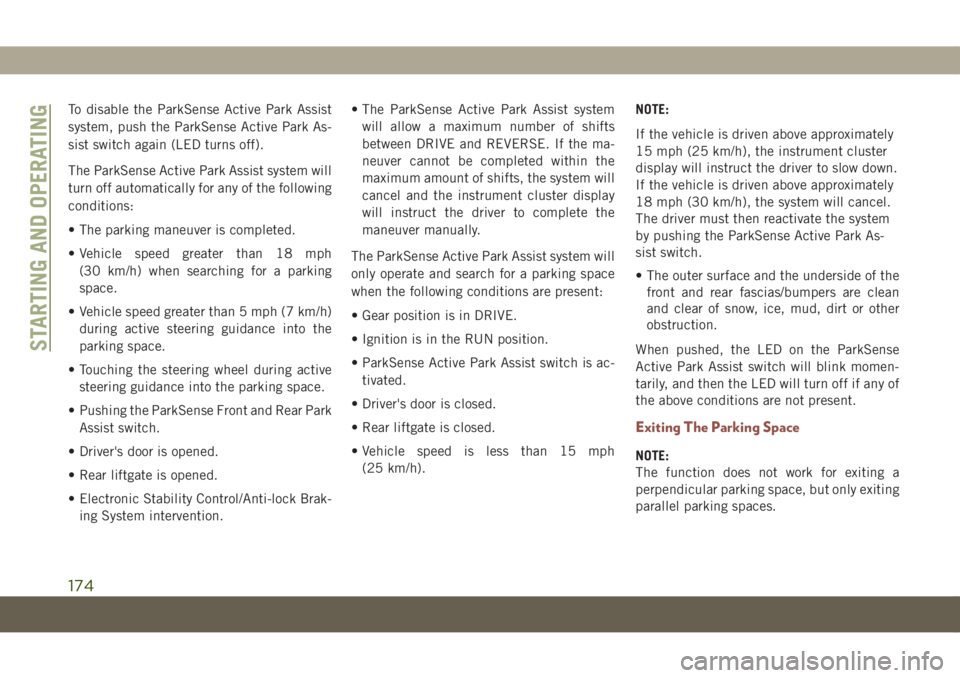
To disable the ParkSense Active Park Assist
system, push the ParkSense Active Park As-
sist switch again (LED turns off).
The ParkSense Active Park Assist system will
turn off automatically for any of the following
conditions:
ŌĆó The parking maneuver is completed.
ŌĆó Vehicle speed greater than 18 mph
(30 km/h) when searching for a parking
space.
ŌĆó Vehicle speed greater than 5 mph (7 km/h)
during active steering guidance into the
parking space.
ŌĆó Touching the steering wheel during active
steering guidance into the parking space.
ŌĆó Pushing the ParkSense Front and Rear Park
Assist switch.
ŌĆó Driver's door is opened.
ŌĆó Rear liftgate is opened.
ŌĆó Electronic Stability Control/Anti-lock Brak-
ing System intervention.ŌĆó The ParkSense Active Park Assist system
will allow a maximum number of shifts
between DRIVE and REVERSE. If the ma-
neuver cannot be completed within the
maximum amount of shifts, the system will
cancel and the instrument cluster display
will instruct the driver to complete the
maneuver manually.
The ParkSense Active Park Assist system will
only operate and search for a parking space
when the following conditions are present:
ŌĆó Gear position is in DRIVE.
ŌĆó Ignition is in the RUN position.
ŌĆó ParkSense Active Park Assist switch is ac-
tivated.
ŌĆó Driver's door is closed.
ŌĆó Rear liftgate is closed.
ŌĆó Vehicle speed is less than 15 mph
(25 km/h).NOTE:
If the vehicle is driven above approximately
15 mph (25 km/h), the instrument cluster
display will instruct the driver to slow down.
If the vehicle is driven above approximately
18 mph (30 km/h), the system will cancel.
The driver must then reactivate the system
by pushing the ParkSense Active Park As-
sist switch.
ŌĆó The outer surface and the underside of the
front and rear fascias/bumpers are clean
and clear of snow, ice, mud, dirt or other
obstruction.
When pushed, the LED on the ParkSense
Active Park Assist switch will blink momen-
tarily, and then the LED will turn off if any of
the above conditions are not present.
Exiting The Parking Space
NOTE:
The function does not work for exiting a
perpendicular parking space, but only exiting
parallel parking spaces.
STARTING AND OPERATING
174
Page 177 of 362
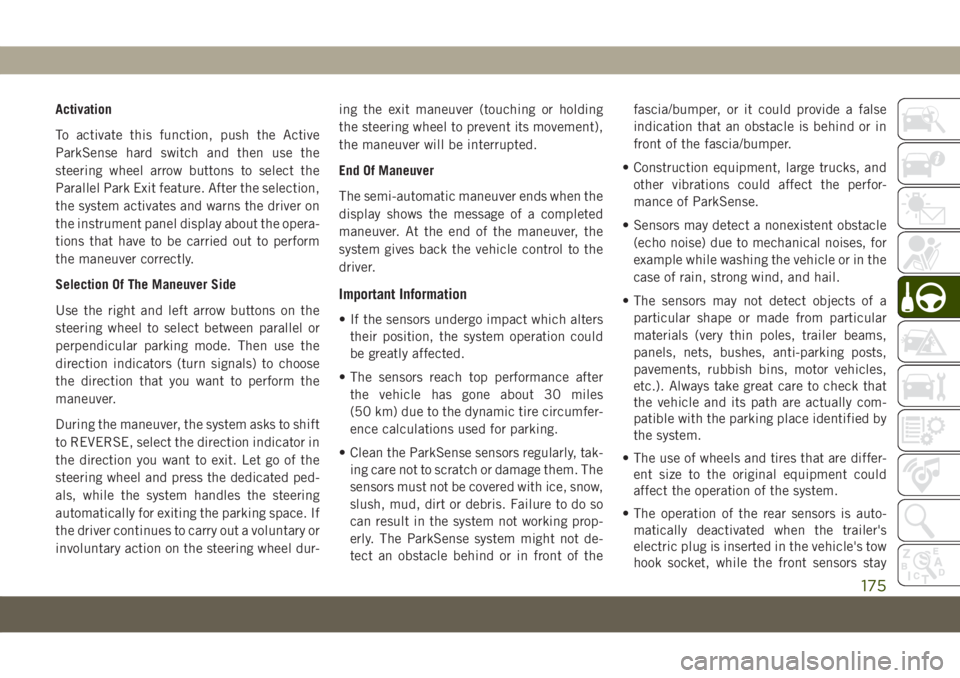
Activation
To activate this function, push the Active
ParkSense hard switch and then use the
steering wheel arrow buttons to select the
Parallel Park Exit feature. After the selection,
the system activates and warns the driver on
the instrument panel display about the opera-
tions that have to be carried out to perform
the maneuver correctly.
Selection Of The Maneuver Side
Use the right and left arrow buttons on the
steering wheel to select between parallel or
perpendicular parking mode. Then use the
direction indicators (turn signals) to choose
the direction that you want to perform the
maneuver.
During the maneuver, the system asks to shift
to REVERSE, select the direction indicator in
the direction you want to exit. Let go of the
steering wheel and press the dedicated ped-
als, while the system handles the steering
automatically for exiting the parking space. If
the driver continues to carry out a voluntary or
involuntary action on the steering wheel dur-ing the exit maneuver (touching or holding
the steering wheel to prevent its movement),
the maneuver will be interrupted.
End Of Maneuver
The semi-automatic maneuver ends when the
display shows the message of a completed
maneuver. At the end of the maneuver, the
system gives back the vehicle control to the
driver.
Important Information
ŌĆó If the sensors undergo impact which alters
their position, the system operation could
be greatly affected.
ŌĆó The sensors reach top performance after
the vehicle has gone about 30 miles
(50 km) due to the dynamic tire circumfer-
ence calculations used for parking.
ŌĆó Clean the ParkSense sensors regularly, tak-
ing care not to scratch or damage them. The
sensors must not be covered with ice, snow,
slush, mud, dirt or debris. Failure to do so
can result in the system not working prop-
erly. The ParkSense system might not de-
tect an obstacle behind or in front of thefascia/bumper, or it could provide a false
indication that an obstacle is behind or in
front of the fascia/bumper.
ŌĆó Construction equipment, large trucks, and
other vibrations could affect the perfor-
mance of ParkSense.
ŌĆó Sensors may detect a nonexistent obstacle
(echo noise) due to mechanical noises, for
example while washing the vehicle or in the
case of rain, strong wind, and hail.
ŌĆó The sensors may not detect objects of a
particular shape or made from particular
materials (very thin poles, trailer beams,
panels, nets, bushes, anti-parking posts,
pavements, rubbish bins, motor vehicles,
etc.). Always take great care to check that
the vehicle and its path are actually com-
patible with the parking place identified by
the system.
ŌĆó The use of wheels and tires that are differ-
ent size to the original equipment could
affect the operation of the system.
ŌĆó The operation of the rear sensors is auto-
matically deactivated when the trailer's
electric plug is inserted in the vehicle's tow
hook socket, while the front sensors stay
175
Page 178 of 362
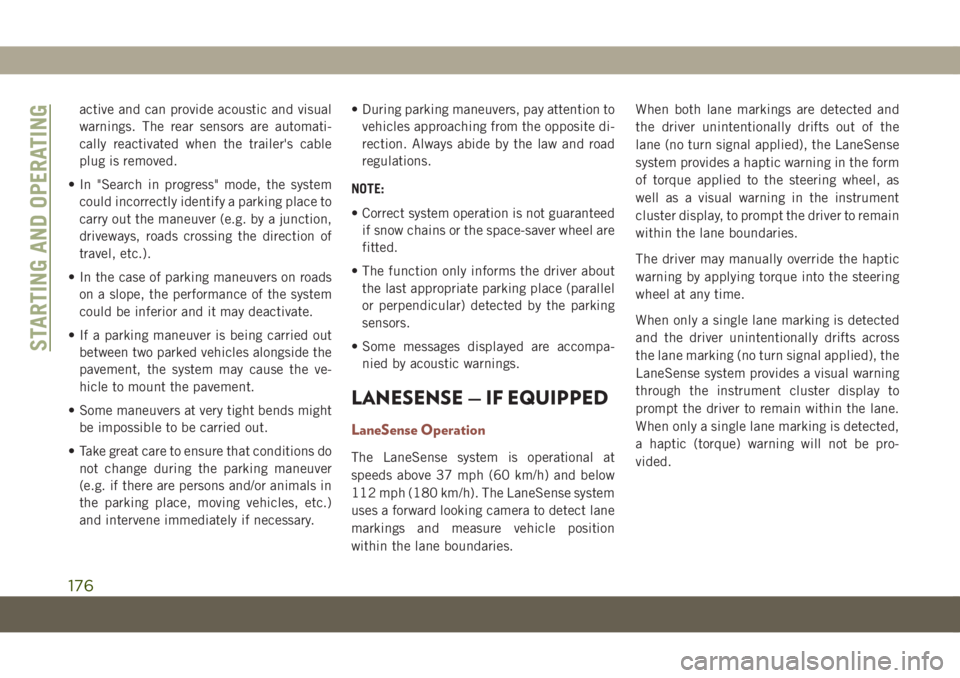
active and can provide acoustic and visual
warnings. The rear sensors are automati-
cally reactivated when the trailer's cable
plug is removed.
ŌĆó In "Search in progress" mode, the system
could incorrectly identify a parking place to
carry out the maneuver (e.g. by a junction,
driveways, roads crossing the direction of
travel, etc.).
ŌĆó In the case of parking maneuvers on roads
on a slope, the performance of the system
could be inferior and it may deactivate.
ŌĆó If a parking maneuver is being carried out
between two parked vehicles alongside the
pavement, the system may cause the ve-
hicle to mount the pavement.
ŌĆó Some maneuvers at very tight bends might
be impossible to be carried out.
ŌĆó Take great care to ensure that conditions do
not change during the parking maneuver
(e.g. if there are persons and/or animals in
the parking place, moving vehicles, etc.)
and intervene immediately if necessary.ŌĆó During parking maneuvers, pay attention to
vehicles approaching from the opposite di-
rection. Always abide by the law and road
regulations.
NOTE:
ŌĆó Correct system operation is not guaranteed
if snow chains or the space-saver wheel are
fitted.
ŌĆó The function only informs the driver about
the last appropriate parking place (parallel
or perpendicular) detected by the parking
sensors.
ŌĆó Some messages displayed are accompa-
nied by acoustic warnings.
LANESENSE ŌĆö IF EQUIPPED
LaneSense Operation
The LaneSense system is operational at
speeds above 37 mph (60 km/h) and below
112 mph (180 km/h). The LaneSense system
uses a forward looking camera to detect lane
markings and measure vehicle position
within the lane boundaries.When both lane markings are detected and
the driver unintentionally drifts out of the
lane (no turn signal applied), the LaneSense
system provides a haptic warning in the form
of torque applied to the steering wheel, as
well as a visual warning in the instrument
cluster display, to prompt the driver to remain
within the lane boundaries.
The driver may manually override the haptic
warning by applying torque into the steering
wheel at any time.
When only a single lane marking is detected
and the driver unintentionally drifts across
the lane marking (no turn signal applied), the
LaneSense system provides a visual warning
through the instrument cluster display to
prompt the driver to remain within the lane.
When only a single lane marking is detected,
a haptic (torque) warning will not be pro-
vided.
STARTING AND OPERATING
176
Page 179 of 362
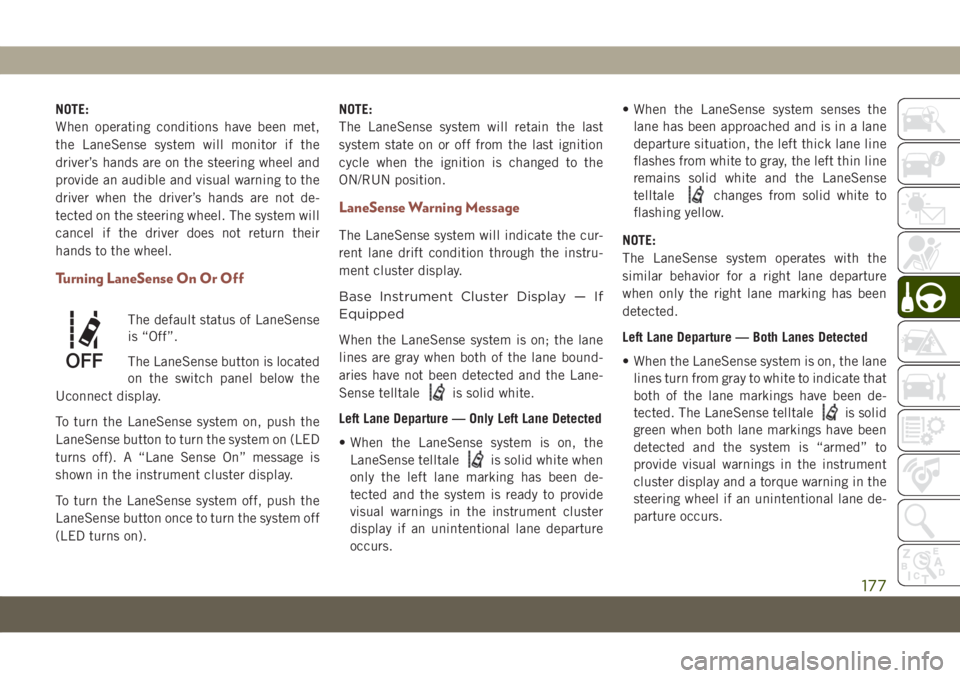
NOTE:
When operating conditions have been met,
the LaneSense system will monitor if the
driverŌĆÖs hands are on the steering wheel and
provide an audible and visual warning to the
driver when the driverŌĆÖs hands are not de-
tected on the steering wheel. The system will
cancel if the driver does not return their
hands to the wheel.
Turning LaneSense On Or Off
The default status of LaneSense
is ŌĆ£OffŌĆØ.
The LaneSense button is located
on the switch panel below the
Uconnect display.
To turn the LaneSense system on, push the
LaneSense button to turn the system on (LED
turns off). A ŌĆ£Lane Sense OnŌĆØ message is
shown in the instrument cluster display.
To turn the LaneSense system off, push the
LaneSense button once to turn the system off
(LED turns on).NOTE:
The LaneSense system will retain the last
system state on or off from the last ignition
cycle when the ignition is changed to the
ON/RUN position.
LaneSense Warning Message
The LaneSense system will indicate the cur-
rent lane drift condition through the instru-
ment cluster display.
Base Instrument Cluster Display ŌĆö If
Equipped
When the LaneSense system is on; the lane
lines are gray when both of the lane bound-
aries have not been detected and the Lane-
Sense telltale
is solid white.
Left Lane Departure ŌĆö Only Left Lane Detected
ŌĆó When the LaneSense system is on, the
LaneSense telltale
is solid white when
only the left lane marking has been de-
tected and the system is ready to provide
visual warnings in the instrument cluster
display if an unintentional lane departure
occurs.ŌĆó When the LaneSense system senses the
lane has been approached and is in a lane
departure situation, the left thick lane line
flashes from white to gray, the left thin line
remains solid white and the LaneSense
telltale
changes from solid white to
flashing yellow.
NOTE:
The LaneSense system operates with the
similar behavior for a right lane departure
when only the right lane marking has been
detected.
Left Lane Departure ŌĆö Both Lanes Detected
ŌĆó When the LaneSense system is on, the lane
lines turn from gray to white to indicate that
both of the lane markings have been de-
tected. The LaneSense telltale
is solid
green when both lane markings have been
detected and the system is ŌĆ£armedŌĆØ to
provide visual warnings in the instrument
cluster display and a torque warning in the
steering wheel if an unintentional lane de-
parture occurs.
177
Page 180 of 362
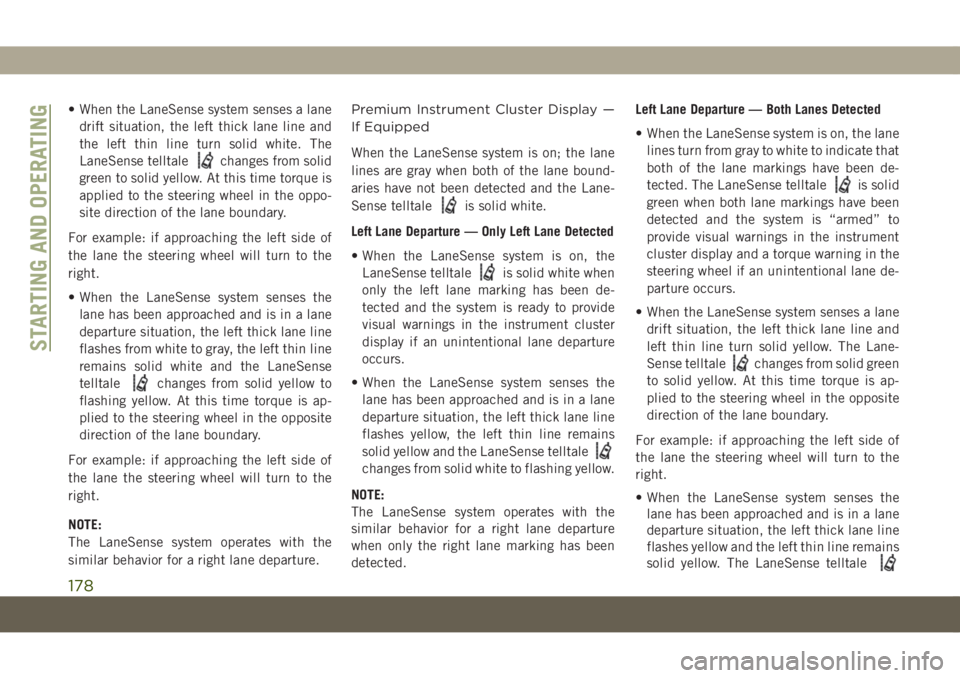
ŌĆó When the LaneSense system senses a lane
drift situation, the left thick lane line and
the left thin line turn solid white. The
LaneSense telltale
changes from solid
green to solid yellow. At this time torque is
applied to the steering wheel in the oppo-
site direction of the lane boundary.
For example: if approaching the left side of
the lane the steering wheel will turn to the
right.
ŌĆó When the LaneSense system senses the
lane has been approached and is in a lane
departure situation, the left thick lane line
flashes from white to gray, the left thin line
remains solid white and the LaneSense
telltale
changes from solid yellow to
flashing yellow. At this time torque is ap-
plied to the steering wheel in the opposite
direction of the lane boundary.
For example: if approaching the left side of
the lane the steering wheel will turn to the
right.
NOTE:
The LaneSense system operates with the
similar behavior for a right lane departure.Premium Instrument Cluster Display ŌĆö
If Equipped
When the LaneSense system is on; the lane
lines are gray when both of the lane bound-
aries have not been detected and the Lane-
Sense telltale
is solid white.
Left Lane Departure ŌĆö Only Left Lane Detected
ŌĆó When the LaneSense system is on, the
LaneSense telltale
is solid white when
only the left lane marking has been de-
tected and the system is ready to provide
visual warnings in the instrument cluster
display if an unintentional lane departure
occurs.
ŌĆó When the LaneSense system senses the
lane has been approached and is in a lane
departure situation, the left thick lane line
flashes yellow, the left thin line remains
solid yellow and the LaneSense telltale
changes from solid white to flashing yellow.
NOTE:
The LaneSense system operates with the
similar behavior for a right lane departure
when only the right lane marking has been
detected.Left Lane Departure ŌĆö Both Lanes Detected
ŌĆó When the LaneSense system is on, the lane
lines turn from gray to white to indicate that
both of the lane markings have been de-
tected. The LaneSense telltale
is solid
green when both lane markings have been
detected and the system is ŌĆ£armedŌĆØ to
provide visual warnings in the instrument
cluster display and a torque warning in the
steering wheel if an unintentional lane de-
parture occurs.
ŌĆó When the LaneSense system senses a lane
drift situation, the left thick lane line and
left thin line turn solid yellow. The Lane-
Sense telltale
changes from solid green
to solid yellow. At this time torque is ap-
plied to the steering wheel in the opposite
direction of the lane boundary.
For example: if approaching the left side of
the lane the steering wheel will turn to the
right.
ŌĆó When the LaneSense system senses the
lane has been approached and is in a lane
departure situation, the left thick lane line
flashes yellow and the left thin line remains
solid yellow. The LaneSense telltale
STARTING AND OPERATING
178